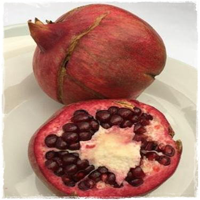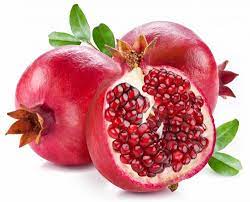 Full List of Fruits
Full List of Fruits  Pomegranate Fruit
Pomegranate Fruit POMEGRANATE FRUIT

The pomegranate fruit is an apple shaped fruit that is red in color on the outside. Inside the pomegranate fruit, there are many small seeds, the pomegranate seeds. The attendance of these little seeds in the pomegranate fruit makes the fruit rather hard to eat but you don't have a choice as there is not much of a flesh which can be separated from the seed. Most people like to eat the pomegranate fruit raw but some use in cooking.
SCIENTIFC NAMES: Pomegranate (Punica granatum L., Punicaceae) is an ancient, beloved plant and fruit. The name ''pomegranate'' follows the Latin name of the fruit Malum granatum, which means ''grainy apple.'' The generic name Punica refers to Pheonicia (Carthage) as a result of mistaken assumption regarding its origin.
POMEGRANATE FRUIT-The pomegranate fruit is a native of the Mediterranean regions and have been growing there for thousands of years. The pomegranate tree was brought into California by Spanish settlers in the 1700's. It is mainly grown for fruit production and tree production in the drier parts of California and Arizona. The actual fruit is in pink color to bright red color and the estimated size is that of a softball. One pomegranate contains approximately 100 calories.
On opening the pomegranate fruit skin there are little fruit sacs inside that looks similar to vitamin E capsules.
 TASTE: The seeds are crunchy and juicy, and add a nice counterpoint to rich dishes like stews and dips. sweet to lightly tart, extremely juicy, sweet, tart, mild citrusy hint.
TASTE: The seeds are crunchy and juicy, and add a nice counterpoint to rich dishes like stews and dips. sweet to lightly tart, extremely juicy, sweet, tart, mild citrusy hint.
The pomegranate is an ancient fruit with a wealthy history, symbol, art, medicine and religion. It has always been an important part of the Middle Eastern diet until lately. However, pomegranates are something of a seasonal novelty in the West. Then medical studies suggested what the ancients believed and Middle Easterners probably take for granted: Pomegranates are really good for all human body to live a healthy life.

 COLORS: Red-purple in color, rind yellowish red, dark red colored arils with soft seeds, red rind with pink colored arils.
COLORS: Red-purple in color, rind yellowish red, dark red colored arils with soft seeds, red rind with pink colored arils.
 USES: People use pomegranate for athletic performance, high blood pressure, diabetes, heart disease and many other conditions, but there is no good scientific evidence to support most of these uses.
USES: People use pomegranate for athletic performance, high blood pressure, diabetes, heart disease and many other conditions, but there is no good scientific evidence to support most of these uses.
LANGUAGES
OTHER NAMES
English
pomegranate
German
Granatapfel
Dutch
granaatappel
Swedish
granatãpple
Danish
granatæble
Norwegian
granateple
French
grenade
Italian
melograno
Spanish
granada
Portuguese
romã
Tamil
Matulai
Hindi
Anaar
The pomegranate tree is a deciduous tree, which bears the fruits and grows to an average height of 5-8 meters in length. The tree initially belongs to the regions of Pakistan, Afghanistan and Iran. These trees have been cultivated since the immemorial time in the Mediterranean regions including Algeria, India, Turkey, Iran and also in some parts of South East Asia, Tropical Africa, peninsular Malaysia, etc. It is available in the months from September to January in the Northern Hemisphere and from March to May in the Southern Hemisphere.
The leaves of the tree are rectangle narrow and have a silky texture. The leaves are 3-7 cms in length and are 2 cms broad. The fruit has a strange hexagonal shape with a thick red skin and around 600 seeds. The fruit seeds range in color from white to deep red. There are also different varieties available in the market, which have a purple squash color. Pomegranate trees are drought understanding and can be grown in dry areas as well. The tree is vulnerable to root decay from fungal diseases in wetter regions. They are also tolerant to moderate frost, and can survive in a temperature of about 10 degree C.
-
When you cut the open a pomegranate fruits skin you will be amazed at the number of ruby-colored seeds inside.
-
Many do not prefer to eat the pomegranate seeds rather they extract the juice from it, though, most of the fiber and antioxidants actually come from the pomegranate seeds.
If you do not like the pomegranate seeds to eat then you can make pomegranate juice... or there is another nice method I use a lot. Take the pomegranate fruit, unopened, and roll it over a hard surface just enough to release the juice from the seeds inside but not breaking the fruit's skin. Then make a small hole and with a straw drink the juice!
-
Pomegranate juice is one of the most delicious juices. There are many brands of pomegranate juice to choose from. If you look in your local grocery stores, you will find a decent selection of pomegranate juices. Some of them taste better than others and even have better health benefits.
When looking for the best pomegranate juice products, the pomegranate juice reviews will come in handy. There are many pomegranate juices and pomegranate juice concentrate products on the market.
Some are cheap and reasonable while the others are more expensive.
| Energy | 346 kJ (83 kcal) |
| Carbohydrates | 18.7 g |
| Sugars | 13.67 g |
| Dietary fiber | 4 g |
| Fat | 1.17 g |
| Protein | 1.67 g |
| Vitamins | Quantity | %DV† |
|---|---|---|
| Thiamine (B1) | 0.067 mg | 6% |
| Riboflavin (B2) | 0.053 mg | 4% |
| Niacin (B3) | 0.293 mg | 2% |
| Pantothenic acid (B5) | 0.377 mg | 8% |
| Vitamin B6 | 0.075 mg | 6% |
| Folate (B9) | 38 μg | 10% |
| Choline | 7.6 mg | 2% |
| Vitamin C | 10.2 mg | 12% |
| Vitamin E | 0.6 mg | 1% |
| Vitamin K | 16.4 μg | 16% |
| Minerals | Quantity | %DV† |
|---|---|---|
| Calcium | 10 mg | 1% |
| Iron | 0.3 mg | 2% |
| Magnesium | 12 mg | 3% |
| Manganese | 0.119 mg | 6% |
| Phosphorus | 36 mg | 5% |
| Potassium | 236 mg | 5% |
| Sodium | 3 mg | 0% |
| Zinc | 0.35 mg | 4% |
| Other constituents | Quantity |
| Water | 78 g |
- The pomegranate fruit shows presence of rich beneficial antioxidants, like polyphenols, tannins and anthocyanins. The antioxidant level of pomegranate juice is higher than in other fruit juices, red wine or green tea.
- Recent research has shown that pomegranates can help fight osteoarthritis, as regular consumption of the juice always reduces down the corrosion of the cartilage.
- Pomegranate juice is also believed to increase blood flow to the heart, and is extremely beneficial for people with ischemic heart disease and some other diseases.
- It is also a good source of vitamins C and B, antioxidant polyphenols, pantothenic acid and potassium.
- Juice of the pomegranate have been found effective in curing atherosclerosis and cardiovascular disease
- The juice of the fruit also has antiviral and antibacterial effects against dental plaque
- Consumption of pomegranate juice has proven to help hugely in cases of prostate cancer or prostatic hyperplasia, diabetes or lymphoma
- Pomegranate juice has also shown to reduce systolic blood pressure by inhibit serum of angiotensin-converting enzyme
At the global level, India is the world's largest producer of pomegranates, followed by Iran. Other countries like Turkey, Spain, Tunisia, Morocco, Afghanistan, China, Greece, Japan, France, Armenia, Cyprus, Egypt, Italy and Palestine also cultivate this fruit crop.
![]() COOKING OF POMEGRANATE:
COOKING OF POMEGRANATE:
The raw seeds are also used to make bright red juice. Pomegranate juice is enjoyed as a beverage, cocktail mixer, and an ingredient in sweet and savory sauces and dishes. The fruit can also be cooked down to make jellies and jams.
1.Pomegranate Tossed Salad
Ingredients:
- 1 md Head lettuce; torn or chopped
- 1 md Cucumber; diced
- 1 lg Tomato; diced
- 1 lg Avocado; diced
- 2 tb Chopped onion
- 1 c Pomegranate seeds
Method:
Toss ingredients and top with favorite dressing. Serves 6. (Note: Garnish your traditional Waldorf salad with pomegranate seeds; add 2/3 cup pomegranate seeds to Fattoush - Arabic bread salad; mix in the seeds with a variety of lettuces, such as radicchio and endive, topping with olive oil and fresh lemon juice..
Ingredients:
- 2 c Apples or pears; diced
- 1 c Celery; chopped
- 1/2 c Nuts; chopped
- 1 c Seedless grapes; halved
- 2 Pomegranates
- 1 Peel of one lemon or lime; grated
- 1/3 c Lemon or lime juice
- 1/3 c Honey
- 1/2 c Salad oil
- 1/2 ts Salt
- 1/2 ts Paprika
- 1/2 ts Prepared mustard
Citrus Dressing
Mix the first four ingredients.Blend with chilled citrus dressing. Spoon into crisp lettuce cup. Halve pomegranate. Spoon out flesh-covered seeds and sprinkle over salad.





























